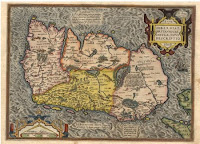 |
| 16th century map of Ireland. |
They use their fields mostly for pasture. Little is cultivated and even less is sown. The problem here is not the quality of the soil but rather the lack of industry on the part of those who should cultivate it. This laziness means that the different types of minerals with which hidden veins of the earth are full are neither mined nor exploited in any way. They do not devote themselves to the manufacture of flax or wool, nor to the practice of any mechanical or mercantile act. Dedicated only to leisure and laziness, this is a truly barbarous people. They depend on their livelihood for animals and they live like animals.This could have been an accurate account of what he saw, but could just as easily have been intended to provide justification for Henry's conquest of Ireland in order to gain for himself and his sons more lands and resources. Pope Adrian IV (the first Englishman to sit the Throne of Peter) had written a papal bull in 1155 called Laudabiliter;* it gave Henry permission to assume control over Ireland and apply Gregorian reforms.
...and that was the second reason for anti-Irish sentiment: Ireland needed to be brought into line doctrinally with the Roman Catholic Church. Catholic missions to Ireland (notably that of the Scotsman, St. Patrick) had introduced Christianity centuries before this. Christianity had survived in Ireland while it suffered in Britain due to invasion from Northern European pagan groups. But the Christianity restored in Britain afterward was closely tied to Rome, while Christianity in Ireland had developed its own practices and rituals.
Old habits are hard to break; "No Irish Need Apply" was not uncommon even in the second half of the 20th century, and Irish stereotypes and persecutions today are no new thing.
*The names of papal bulls don't always signify their topic; in this case, it is named for the opening word, which says (in English) "Laudably and profitably doth your Majesty consider how..." N.B.: scholars have argued for the last few centuries over the authenticity and authority of Laudabiliter, but for the present purpose, we can accept that it was very real for the 12th century.
I'd never heard St. Patrick called a "Scotsman" before. Tradition holds that St. Patrick was English, or possibly Welsh; the Scots remained unconverted until the Irish St. Columcille brought Christianity to Scotland in the Sixth Century.
ReplyDeleteFor Patrick, I go to the source that has the greatest stake in historical accuracy, not "tradition"; that would be the Catholic Church, which has worked in modern times to verify the existence of saints (St. Christopher and St. George who battled the dragon, for instance, have had their feast days suppressed because they are really just good stories, not real people).
ReplyDeleteThere's great controversy over the "two Patricks" that's worth talking about, but the one the RC Church cares about was born at Kilpatrick in Dumbarton, Scotland, then captured as a teen and made a slave in Ireland. It was after his escape at 20 that a dream told him to return to preach in Ireland.
http://www.catholic.org/saints/saint.php?saint_id=89
Thanks for being the first person to comment on a post! I would love for this blog to become more interactive (at least I would know that someone was reading it!).